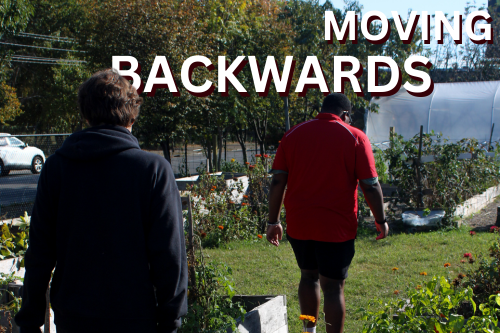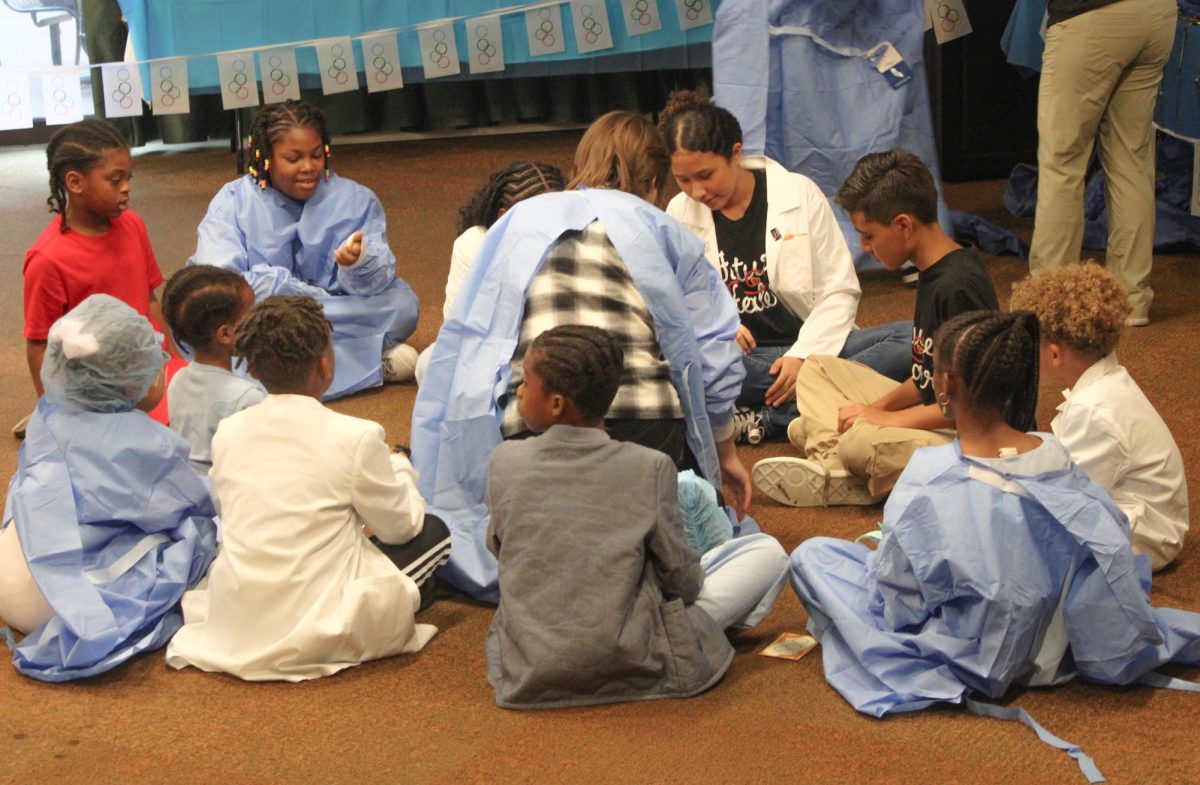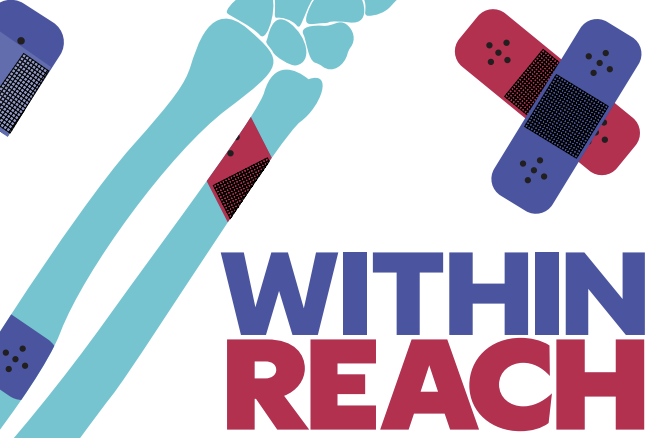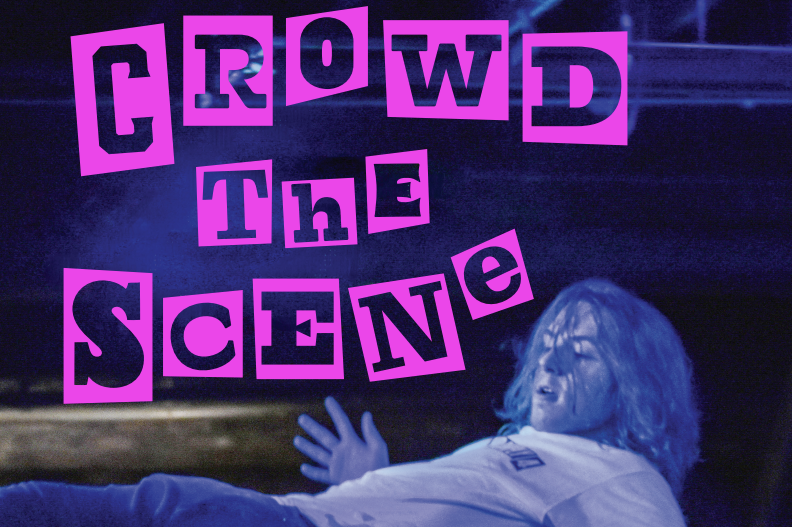Styrofoam cups reading “TONS OF FLAVOR” covered the sidewalk next to a fallen Thorntons’ trash can. Unimportant to the passing customer, the pile continued to grow. Come rainfall, the trash flowed seamlessly over the concrete parking lot and into other areas of town, sliding by curbs and into storm drains along the way. Over the next 48 hours, the cups, chip bags, and cigarettes made their way to one of Beargrass Creek’s three forks. The trash continued downstream and arrived at the confluence, the spot where all three forks converge. Marked by a fallen tree, the confluence’s natural debris picks up everything in its path, including the styrofoam cups.
At least, that’s the path I imagined upon finding the now unrecognizable pieces of trash. “Ten styrofoam pieces, two cigarettes, eight chip bags,” I yelled to my teammate, Sam Howlett, an 18-year-old student at the University of Kentucky. We, along with our two other teammates, had climbed off an overpass on Frankfort Avenue and down the adjacent mudslide, after seeing the pile of white cups and plastic bags at the confluence. Out of all of our outings so far, we had hit the trash jackpot.
Over the summer, I worked as an intern at the University of Louisville (UofL) at the Christina Lee Brown Envirome Institute on the Beargrass Creek Team. Funded by a joint grant with Notre Dame from the National Science Foundation, our primary investigator, Dr. Faisal Aqlan from UofL, tasked our team with tracking macroplastics in Beargrass Creek. Unlike a traditional 9–5, we spent every day knee-deep in each of the three forks of Beargrass Creek, tracking each piece of trash we saw in the Marine Debris Tracker app. By the end of the summer, we had tracked over 3,000 pieces of trash. About 700 of those were plastic bags. Over 400 were plastic cups.
“The hope is to continue the project,” Ashley Jaggers, the project manager, said.
After one successful round of data collection, my team and I were left with even more questions.
Until this summer, our team was unaware of how close we truly are to the creek and how pervasive it is throughout Louisville. More than that, none of us knew the condition of the creek or how to help it. Beargrass Creek slips by neighborhoods, under highways, and through woods, going unnoticed by many Louisville residents but cutting through the city. Helping it requires the involvement of not only Louisville leaders, but each community member as well.
Beargrass Creek is split into three forks — Muddy, Middle, and South — over a watershed of 60 square miles. Each fork is distinct, characterized by both its geographic and socioeconomic surroundings.
The cleanest of the three, Muddy Fork, is the northernmost, running through Butchertown, Indian Hills, and the Clifton neighborhood. Unfortunately, it lives up to its name. When tracking trash in Indian Hills, my team ran into a situation we liked to call “quick-mud.” My teammates and I let out a defeated sigh in unison after one step in the mud engulfed our entire calves in the smelly sludge. It took 20 minutes and a joint effort to pull our boots out of the mud and continue on our hike.
Now, although clean, Muddy Fork is also the most secluded, inaccessible fork, surrounded by woods, private property, and worst of all, channelization.
Muddy Fork is channelized where it runs parallel to the Ohio River, a process in which stream banks are physically rerouted, often with concrete or boulders, to straighten and increase the natural flow of water. However, while a straight creek makes building around the water easier, this urban benefit may be outweighed by the environmental consequences.
“It makes it almost invisible for the average person. So they litter more. So it’s just like a big parking lot,” Dr. David Wicks said.
Wicks is an avid Beargrass Creek expert and professor at UofL— almost always sporting his safari hat and life jacket while on the job — focused on restoring the creek through community education, involvement, and government action. He collaborates with various government agencies, such as the Louisville Metropolitan Sewer District (MSD), along with teaching a creek class at UofL. In fact, Wicks, along with Dr. Tamara Sluss, a sustainability professor at UofL, worked as project mentors throughout the Beargrass Creek summer project, providing guidance along the way.
Contrary to Muddy Fork, Middle Fork is heavily accessible to the public, running through Cherokee and Seneca Parks, both part of the Olmsted Parks Conservancy. Middle Fork is home to popular gathering spots such as Big Rock, which is covered in “no swimming” signs, yet filled with families in bathing suits who often leave behind food wrappers and soda cans. More people means more trash.
Similarly, while the South Fork runs through portions of urbanized Louisville, such as Germantown and Buechel, it also flows through Joe Creason Park, a popular spot for runners and hikers. As a result of its high levels of human accessibility, especially near major roads such as Hikes Lane, South Fork is the most polluted of the three forks.
When the word “pollution” is brought up, it is often associated with throwing a takeout box out of the car window or tossing a cigarette on the ground. Pollution, though, is not limited to the conscious act of littering. In the 1800s, Beargrass Creek was originally a dumping ground for sewage and animal carcasses. This identifiable source of contamination is categorized as “point source pollution,” but luckily, the creek has exited such a phase.
“Now it’s almost the harder part,” Wicks said. Waste in the creek has shifted toward “nonpoint source pollution,” arriving from everywhere, but almost impossible to track. This tracking inability can be attributed to surface runoff, specifically concentrated to impervious, paved surfaces.
“Surface runoff is the single most detrimental factor to the creek’s pollution, being that trash from miles away can wash up into the creek over a certain time span,” Howlett said.
During rainfall, all of the items in parking lots, business parks, and even roads take a first class trip to Beargrass, picking up partners along the way.
“All trash that’s on the ground is going to end up in our water,” said Angela Page, a duPont Manual High School biology teacher focused on Beargrass awareness. “It’s going to get carried there eventually, and then it’s going to go into the Gulf of Mexico, because it’s going to get carried by the Ohio River.”
Pollution is not limited to solid objects, though. Often, the biggest source of pollution is invisible, but also right under the community’s nose. Stormwater runoff of fertilizers, fuels, and even soap to wash cars will eventually end up in the creek. Also a result of heavy rainfall, combined sewer overflows (CSOs) trigger a flood of stormwater and wastewater into bodies of water, such as Beargrass Creek, when the sewage system hits capacity. Such overflows may contain untreated human and animal waste, industrial waste, sediments, and other chemicals.
As the Louisville community and government becomes aware of these habitat threats, it raises the question: Whose job is it to fix Beargrass Creek?
The relationship between citizens and their government is a hotly contested topic. Because Beargrass falls into a gray area between government and citizen obligation, it can easily be lost in the shuffle. With this said, there are current governmental policies in place, to end and prevent pollution in Beargrass Creek.
On October 18, 2022, MSD celebrated the 50th anniversary of the Clean Water Act of 1972 by announcing the completion of their new Waterway Protection Tunnel. This four-mile underground tunnel will limit sewage overflows and wastewater contamination, previously harming Beargrass Creek, by taking pressure off of the sewer system.
“We have reduced our combined sewer overflow volume by six billion gallons,” said Stephanie Laughlin, MSD’s infrastructure planning program manager.
In addition to overflow management, MSD has tracked water quality, specifically in the Middle Fork, in order to advise further watershed planning efforts. Colette Easter, MSD’s municipal separate storm sewer system program administrator, played a main role in such data collection.
“We were able to leverage that long-term data, but also partner with our citizens to better understand and better characterize some of the challenges that we can actually address as a community through that watershed planning effort,” Easter said.
On a larger scale, MSD assisted the U.S. Army Corps of Engineers (U.S.A.C.E) as a local sponsor to conduct the Three Forks of Beargrass Creek Ecosystem Restoration Feasibility Study with the addition of federal funding.
“We were the only inland community that received ecosystem restoration funding,” Erin Wagoner, the community benefits and partnerships manager at MSD, said.
The feasibility study includes a 121 million dollar plan that will restore over eight miles of stream and around 600 acres of land at 12 sites.
“The main point of this plan is to create habitat,” said Laura Mattingly, a USACE project manager on the feasibility study.
The USACE performed habitat units that determined the allocated sites based on ones that would have a greater difference, what Mattingly refers to as a “habitat lift.” To achieve this, the plan will work to add and maintain wetlands, plantings, recreation, instream habitat, and native species over an estimated 10–15 years.
“What we do isn’t going to make it perfect, obviously, but it’s a start,” Mattingly said.
However, government-funded ecosystem restoration has the potential to become a money pit if not preserved by Louisville citizens.
“Most of this litter can get removed pretty quickly,” Wicks said. “It just gets replaced pretty quickly.”
One citizen stepping up to the plate is Page. Before teaching at Manual, Page taught Advanced Ecology, or what was better known as “the creek class,” at Louisville Male High School with the help of Wicks.
“We would typically run kind of a class project, and it would be either individuals or groups depending on the students,” Page said.
Leaving every other day to go to the creek, Page and her students researched water quality, trash, and even made a plastic water bottle boat — all while making it back for fourth block. In one outing, the class came across a 1963 Volkswagen Bug, and soon enough, MSD received a call from Wicks and Page to fish out the VW with a crane. The research performed in those three-hour blocks, from erosion studies to photographing litter, inspired some of her most driven students to pursue a career in water studies and environmental sciences.
“They come to life when you take them out there,” Page said. “They move differently.”
Awareness about the creek is the key to improvement. Without it, the creek could keep flowing through woods, malls, and neighborhoods, completely unnoticed. In order to tackle pollution in the creek, it is important to get to the root of the problem.
“The litter gets onto the pavement somehow,” Wicks said. While the blame can be placed on surface runoff, the origin of pollution lies in the hands of Louisville residents.
But how can we combat such a problem? How can we stop litter?
“Have people move out of Louisville,” Wicks joked. “It’s education.”
Beargrass Creek is often referred to as the “creek in our backyard,” running through the most popular places and parks of Louisville and being a prime spot for recreation. Despite many beautiful spots, it can be easy to ignore the sections that no longer resemble a creek. Whether it starts in school or in free time, engaging in the creek may be stronger than billions of dollars thrown at the problem.
“If locals are more aware of the positive contribution they can make, huge steps will be made to protecting the Beargrass Creek,” Howlett said.
To inspire such engagement, it is imperative to educate Louisvillians on the amount of power they hold. “No swimming” signs pop up all over Louisville in an effort to warn people about the harms of the creek, but is it more important to warn people about the harms that they present?
“When we talk about nonpoint source pollution, we’re talking about things that are actually very tangible for the public to be involved in,” Easter said.
By simply limiting one’s litter and chemical use, citizens can do their part to create a healthier creek.
“I think everything comes down to cultural awareness,” Aqlan said. “If we have that in mind, then everyone can do something.”
However, in order to be motivated enough to create change, there must be a level of emotional obligation.
“You have to go, and be at the creek, and just be quiet,” Page said.
So much of our infrastructure is centered around Beargrass Creek. So, if we’re built around Beargrass, why aren’t we working with it? Louisville is urbanizing. While parking lots expand, greenery shrinks. Forgetting the nature on which this city is founded has proven itself detrimental to the diversity and health of Louisville’s habitat and ecosystem, primarily in Beargrass Creek.
This doesn’t mean that the creek is unfixable. MSD and the USACE, for example, have first hand experiences with Louisville’s growing advocacy for Beargrass Creek as more citizens become aware of its status and beauty.
“That project actually originated with an application from the city,” Laughlin said.
Spurred by the parks department, awareness regarding Beargrass Creek is gaining momentum.
“There’s just tons of people that really, really care about it. And they love the history of it,” Mattingly said.
Advocacy, awareness, and simply seeing the creek, can sometimes be enough to evoke the attachment to which Mattingly refers.
“Just pick out a spot and look at it,” Wicks said. “Skip studying for a while, and enjoy life.”
















